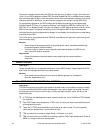
46 S-ICX (International) issued October 2000 S-ICX-50-200
Overview
This chapter describes the many features that end-users can perform on S-ICX station phones. Some
of the most popular functions are highlighted below. A complete list of Station Features is included at
the end of this chapter.
Popular Station Features
ABSENCE MESSAGE
Description:
Extension users can leave text messages on their phones when they are away. When the
unattended extension is dialled, the text message displays on the caller’s phone.
Benefits:
• Allows extension user to send a message to someone who calls when the extension
user is away.
ACCOUNT CODE CAPABILITY
Description:
This feature works with Station Message Detail Recording (SMDR/Call Logging). During a phone
call, a station user can silently enter an accounting or client billing code. The entered Code will
display on the phone’s LCD as it’s dialed, so the user can tell it’s being registered. Subsequent
SMDR/Call Logging reports will show the Code dialed for each call.
There are two different types of account codes you can use in the S-ICX:
Non-Verified Account Codes: Codes that aren’t checked by the system for validity; the user
can enter anything from 1-10 digits long. Individual phones can be programmed to accept
forced Account Codes (the user must enter a code for every call) or voluntary Account Codes
(the user can enter a code, but doesn’t have to, for each call).
Non-Verified Account Codes can be assigned to incoming and/or outgoing calls. For incoming
calls, the user can enter the Code anytime during the call. For outgoing calls, the user either
enters the Code before accessing an outside line (for forced Codes), or anytime during the
call (for voluntary Codes).
Verified Account Codes: Codes entered by phone users that must match a code of up to 10
digits that has been pre-programmed into an Account Code Table. If the dialed Code doesn’t
have a matching entry in the Table, the user gets fast-busy and is unable to place the call.
These codes can also be either forced or voluntary. You can program these codes with their
own Toll Restriction Service (TRS) or Call Barring. Class assignment so that, when entered,
they will override the extension’s TRS Class (which would normally be used to allow/restrict
the call).
Chapter 4 - Station Features


















